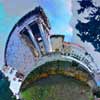Travel PULA AND ITS HISTORY
The region around Pula can look back on a history of around 7,000 years. The city itself was founded approximately 1000 BC by the Illyrian inhabitants of Istria. As so often legends entwine themselves around the emergence of the city. Jason and the Argonauts play a role, the stolen golden fleece, and refugees who wanted to bring it back and lost the leader. They founded Pula, the "refugee city".
The favorable geographic position on the southern tip of Istria, the natural harbor basins along the coast and a blessed landscape where wine and olive oil thrive especially made the city a destiny.
The favorable geographical location of the city became a fate.
It was successively Roman military base, was conquered by the Ostrogoths, came under the power of Byzantium, under Franconian rule, Venice rule, was destroyed by the Genoese in the late Middle Ages, robbed by them. At that time Pula had only 300 inhabitants. But again and again it was about the harbor. Venice has expanded it again, then Austria. The city experienced a boom when Emperor Franz Joseph I built in Pula the largest Austrian harbour of war. It is not nice, what the Austrians have built there with shipyard, naval barracks, machine school, naval hospital, etc. But in about 30 years, the city population exploded from just 900 to more than 25,000 residents. What was built by the Austrians today still decisively shapes the cityscape.
The booklet for tourists "Pula, history, culture, artistic heritage" states: "What makes Pula a particularly interesting destination and gives the city a special character, are especially its valuable monuments of art and architecture from antiquity and the Middle Ages". Everything between the time of the Romans and today shapes the city, but can not be considered as an interesting destination. And as the new tourist facilities marina and holiday villages are not interesting for me, especially in this season, only the old Roman buildings remain to be visited. But for me, people are really the interesting aspect in a city. As I do not speak Croatian, however, I have problems to really get in touch. Nevertheless, that's what interests me.
Has the harbor, here as; Computer Watercolor, has this engine of development a future? At the moment it does not look like it. The harbor looks sleepy and almost touching - not idyllic - if you compare it with really lively harbors, such as the Port of Hamburg or Rotterdam. Nevertheless, I can imagine a development. The magic word may be called TEN (Trans-European Networks). With this priority program, the EU wants to achieve better networking in the single market with highly subsidized projects. The freight train route Rotterdam - Genoa through the Alps is under construction. But freight transport over the Alps is expensive. A second route, which bypasses the Alps in the east, is currently under discussion. It starts in a Greek port. But from Pula via Zagreb and Vienna to Berlin, the route would only be half as long. Construction and transport costs would fall drastically. This is possible at any time. The port of Hamburg has a gross value added of 22 billion euros - per year! And its location on a river is unfavorable for large ships. Pula is ideal in comparison. The history of this city is therefore not yet over.
Here: Panorama Harbour
Here:Austrian Admiralty at the harbor
Here:The sea
